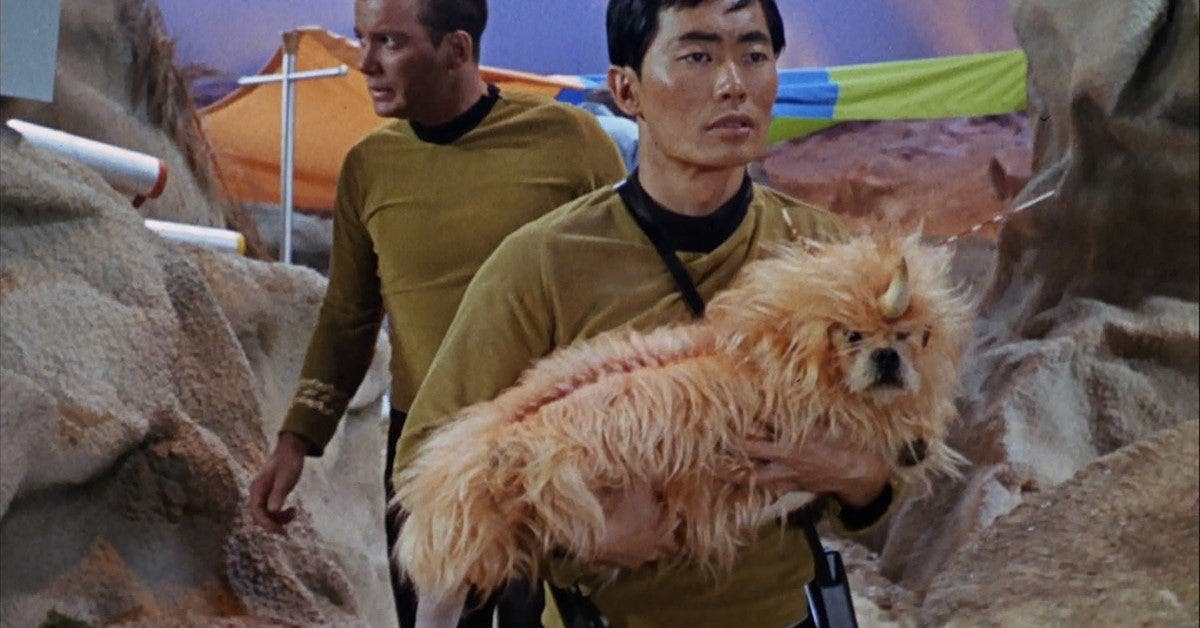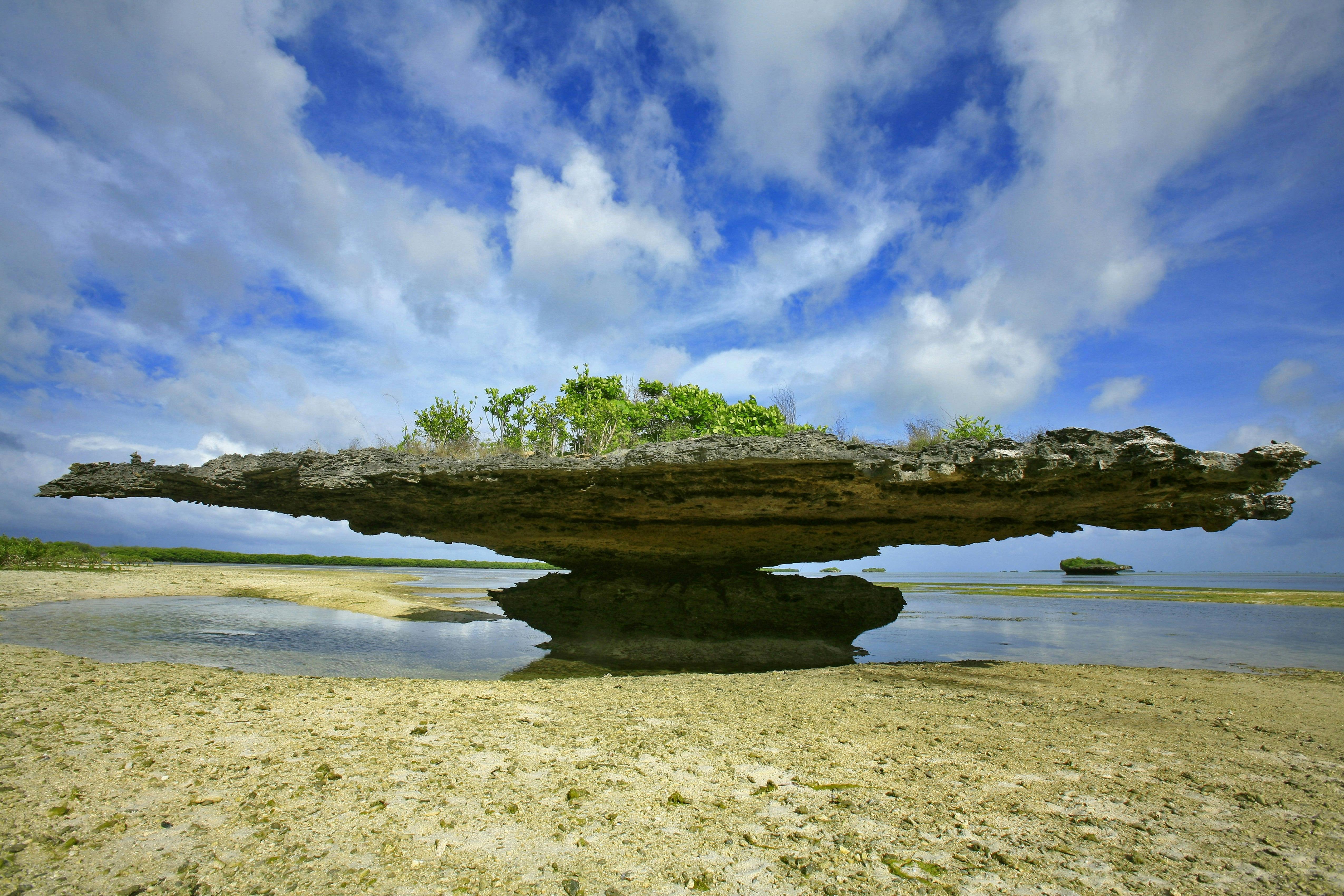Published Jun 24, 2019
Why Do Some Aliens on 'Star Trek' Look Like Humans?
Turns out, science has an answer for that.

StarTrek.com
Shimmering light breaks the skyline of a desolate alien landscape, hovering just above the ground. A smattering of rocks and foliage dot the area. The light coalesces as the U.S.S. Enterprise orbits overhead, little more than a speck of light in a sea of stars. An away team appears on the alien planet, tricorders at the ready, prepared to explore this strange new world. This is what they signed up for. This is the payoff earned after a lifetime committed to the ideals of the Federation and Starfleet: To seek out new life and new civilizations. Surely, here, on this distant globe, they’ll find it.
And yet, while the life they encounter is new, it is wholly familiar. It seems that life in the Alpha Quadrant is built upon an almost singular, very humanoid, blueprint. Of course, the various iterations of the Enterprise have encountered truly strange life forms in its travels. The Horta, a silicon-based alien which feeds on rocks, or the Crystalline Entity with its unmatched beauty and insatiable hunger, come to mind. But by and large, the life encountered by the various crews of Star Trek canon look as though they might hail from an alternate Earth on which evolution took a minor turn.
This was a common problem of early science fiction media. Visual technology lagged behind our imaginations and, compromises had to be made. Special and makeup effects were crafts in their infancy, limited both by what could be physically made and by the available budget. The results were a whole lot of aliens which looked like humans with facial prosthetics, and — in one infamous Trek moment — dogs wearing horns.

StarTrek.com
Star Trek: The Next Generation provided a satisfying explanation for the pervasiveness of the humanoid form throughout the Alpha Quadrant with the episode "The Chase." In it, Captain Picard is visited by Richard Galen, a mentor and archaeology professor from his youth. Galen has spent the last decade of his life in pursuit of a discovery which promised to shake the foundations of history, not just for humanity, but for all life in the quadrant. He traveled to the Enterprise to invite Picard to join him in his research. Flattered and intrigued as Picard is, he is unwilling to leave his post, saying, “If I go, I go for good. And that’s not something I’m prepared to do.” But when Galen’s shuttle is attacked, resulting in his death, Picard delays their current mission to fulfill Galen’s last wish.
DNA fragments obtained from the shuttle’s on-board computer reveal themselves to be pieces of a puzzle which, when combined with fragments obtained by Klingon and Cardassian crews, unveil a holographic message from a long-dead humanoid species.
The crew learns that life throughout the Alpha Quadrant was seeded by these ancient people after they found themselves alone in the vastness of space. This explains why, despite hailing from distant worlds, life throughout our corner of the galaxy appears so similar. It also provides for a signature Trek moment in which historically opposed populations are made to examine their similarities and see one another in a new light. This is the stuff for which Star Trek was made.

StarTrek.com
The common wisdom, back here in reality, is that aliens hailing from an entirely independent environment would be drastically different from life found on Earth. Scientists from Carl Sagan to Stephen Jay Gould have put their chips on the table, betting that alien life will likely be different from anything we would recognize. After all, just look at the variety of life present on our own planet and you can see the myriad ways biology contrives to solve the problem of living and navigating an environment. That said, it’s not entirely outside the realm of possibility that life elsewhere might look more like us than we previously supposed.
Panspermia

DEA/ICAS94
The origin of life on Earth is, perhaps, the most vital mystery we’ve attempted to answer. We know, from the fossil record, that simple single-celled life was present at least as far back as 3.7 billion years ago, and some scientists believe it must have appeared on Earth even earlier. The question of when life took a foothold on our planet is one we can answer with relative certainty, but the how of it is more difficult.
One hypothesis is Panspermia, the idea that life was seeded from elsewhere in our solar system or beyond, not by intelligent entities, but by celestial debris.
The early solar system was a hotbed of collisions, with matter being shared between planets and moons. We’re still discovering fragments of Mars which, after making the long trip through space, found their way to Earth’s surface. And some scientists believe those ancient rocks might have carried life with them. The idea isn’t as far-fetched as it might seem.
Evidence suggests that Mars might have been habitable roughly 3.7 billion years ago, which lines up nicely with the emergence of life on Earth. There’s no evidence of macroscopic life on Mars today. There is, in fact, no direct evidence of life there at all, past or present. But the conditions were such that microbial life could have found a home there, and the presence of methane suggests they might still be there today. If that’s the case, it’s possible ancient Martian microbes might have hitched a ride on an interplanetary meteorite or comet headed for Earth.
Research presented by Dina Pasini, from the University of Kent, at the European Planetary Science Congress supports the possibility of life surviving the trip between worlds.
Their experiments were designed to replicate conditions microbial life might experience when traveling through space and impacting a planet. Pasini used frozen samples of Nannochloropsis, a microscopic marine algae. The samples were loaded into a two-stage light gas gun, accelerating them to speeds of 4.31 miles per second (6.93 kilometers per second), and fired into water. This simulates entering the atmosphere and crashing in the ocean.
As expected, the faster samples were accelerated, the higher their chances of of death were. But there were survivors, suggesting that it is possible for some forms of life to make the trip and survive the impact. And if they find a suitable environment upon arrival, especially one devoid of any competitors, there’s little reason that life would not propagate.
You can think of it like seeds being blown across vast distances by the wind. Some may land on stones or in areas without the right conditions and never germinate. Others might find the right conditions for sprouting, but be choked out by competitors. Some, though, will find hospitable conditions and thrive. That’s how panspermia is thought to work. Primitive life, or the building blocks thereof, could cast about on the cosmic winds, just looking for a nice place to settle down.
Panspermia is, as yet, still unproven but it does provide one possible path by which life of a common origin might exist on more than one world. Life such as this would share a common ancestry even if separated by immeasurable distance.
The Limits of Evolution

StarTrek.com
The galaxy is big, astronomically so. There are hundreds of billions of stars in the Milky Way and exoplanets are being discovered all the time. The number of worlds with the potential for life are seemingly limitless. One could imagine an equally limitless array of life which might populate those worlds, each one more bizarre than the last, but those forms might be more finite than all that.
Charles Cockell, Professor of Astrobiology at the University of Edinburgh’s School of Physics and Astronomy literally wrote the book on this topic. The Equations of Life: How Physics Shapes Evolution breaks down Cockell’s argument for the limitations on the way evolution can manifest. Cockell argues that life is constrained by the laws of physics at every level of development — from the chemical elements used to construct an organism, to the ways it adapts to its environment.
We spoke with Professor Cockell, via email, about his hypothesis and why the forms life takes, throughout the universe, might be more limited than we previously thought.
“Carbon is the most versatile element with which to build molecules. The periodic table is universal, so we would expect that living things would also explore the same elements elsewhere and likely stumble across carbon as the most likely element to build complex molecules.” Cockell continued, “I think life would be recognizable. Life will tend to converge on similar solutions to physical problems - sensors to detect electromagnetic radiation (eyes), streamlined bodies to move fast through liquids. Many of these solutions are determined by physics, not by chance events in evolution. If we found life elsewhere, we might expect it to have similar solutions to survival.”
The process of divergent life evolving into similar forms in similar environments is called Convergent Evolution and one interesting example has been in the news of late.
Aldabra, the world’s second largest coral atoll, was completely submerged 136,000 years ago and every land-dwelling species was wiped out. The fossil record shows the presence of a flightless bird, the Aldabra rail, which called the Atoll home before the inundation event.
Extinction events are tragic, but common, throughout the Earth’s history, but what makes this one special is it didn’t spell an end, only a hiatus, for at least one of the species which called the atoll home. The flightless rail has re-emerged on the Aldabra Atoll. According to a publication in the Zoological Journal of the Linnean Society, “A flightless Dryolimnas has been identified from two temporally separated Aldabran fossil localities, deposited before and after the inundation event, providing irrefutable evidence that a member of Rallidae colonized the atoll, most likely from Madagascar, and became flightless independently on each occasion.”
In simple terms, what this means, is there was a flightless Rail living on Aldabra more than a hundred-thousand years ago. The atoll was swallowed by the ocean, killing off all land-based species. And when the atoll re-emerged, the flightless Rail evolved again.
This suggests that life is, indeed, constrained and will find recognizable solutions to problems, particularly when presented with a similar starting point and environment. Professor Cockell agrees, saying, “This does show that solutions to survival are limited. The niches that life adapts to can produce different creatures ,as the fossil record shows, but solutions to living are not unlimited. Consider streamlined bodies - in dolphins (mammals), sharks (fish) and ichthyosaurs (extinct reptiles). This is a physical solution to moving fast through water - set by hydrodynamics.”
Considering what we now know about life’s ability to survive extreme situations and environments, and the ways physics shape evolution of species, it doesn’t seem so bizarre that life found on M-class planets, planets with environments similar to our own, would be familiar.
In fact, if Professor Cockell is right, finding life drastically different in a similar environment to Earth, elsewhere in the galaxy would be the truly shocking discovery. When humanity does finally endeavor to explore the stars, some combination of panspermia and convergent evolution could result in a galaxy filled with life which looks an awful lot like what we see in Star Trek. Because even though we don’t hail from the same planet, we share a universe, bound by the same laws and pressures.
We will, in the end, just have to wait and see. No matter what we find when we do finally cast our ships into the vast cosmic seas, we’d do well to remember the central message of "The Chase"... whatever our origins, we are more similar than we might suppose.

